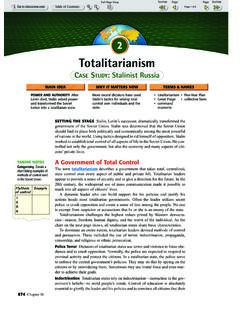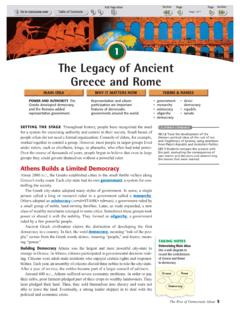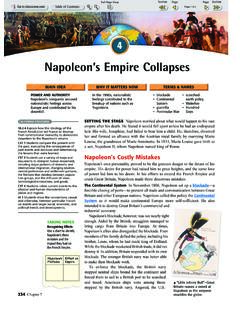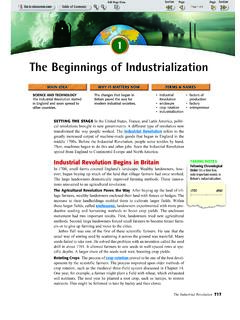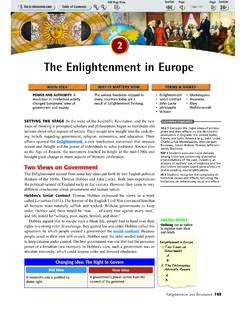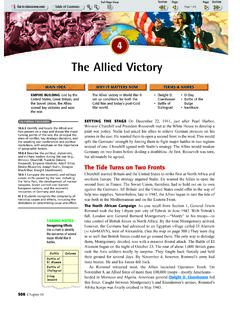Transcription of British Imperialism in India - History With Mr. Green
1 The Age of Imperialism357 MAIN IDEAWHY IT MATTERS NOWTERMS & NAMESEMPIRE BUILDINGAs theMughal Empire declined, Britainseized Indian territory and sooncontrolled almost the , the second mostpopulated nation in the world,has its political roots in thiscolony. sepoy jewel inthe crown SepoyMutiny Raj4 SETTING THE STAGEB ritish economic interest in India began in the 1600s,when the British East India Company set up trading posts at Bombay, Madras,and Calcutta. At first, India s ruling Mughal Dynasty kept European tradersunder control. By 1707, however, the Mughal Empire was collapsing. Dozens ofsmall states, each headed by a ruler or maharajah, broke away from Mughal con-trol. In 1757, Robert Clive led East India Company troops in a decisive victoryover Indian forces allied with the French at the Battle of Plassey.
2 From that timeuntil 1858, the East India Company was the leading power in Expand Control over IndiaThe area controlled by the East India Company grew over time. Eventually, itgoverned directly or indirectly an area that included modern Bangladesh, mostof southern India , and nearly all the territory along the Ganges River in the India Company DominatesOfficially, the British government regulatedthe East India Company s efforts both in London and in India . Until the begin-ning of the 19th century, the company ruled India with little interference fromthe British government. The company even had its own army, led by British offi-cers and staffed by sepoys, or Indian soldiers. The governor of Bombay,Mountstuart Elphinstone, referred to the sepoy army as a delicate and danger-ous machine, which a little mismanagement may easily turn against us.
3 Britain s Jewel in the Crown At first, the British treasured India more for itspotential than its actual profit. The Industrial Revolution had turned Britain intothe world s workshop, and India was a major supplier of raw materials for thatworkshop. Its 300 million people were also a large potential market for British -made goods. It is not surprising, then, that the British considered India the bright-est jewel in the crown, the most valuable of all of Britain s British set up restrictions that prevented the Indian economy from oper-ating on its own. British policies called for India to produce raw materials forBritish manufacturing and to buy British goods. In addition, Indian competitionwith British goods was prohibited. For example, India s own handloom textileindustry was almost put out of business by imported British textiles.
4 Cheap clothand ready -made clothes from England flooded the Indian market and drove outlocal Imperialism in IndiaRecognizing EffectsUsea diagram to identify theeffects of the three NOTESC ause1. Decline ofthe MughalEmpire2. Colonialpolicies3. SepoyMutinyEffectCALIFORNIA the rise of industrialeconomies and their link to Imperialism andcolonialism ( , the role played by nationalsecurity and strategic advantage; moralissues raised by the search for nationalhegemony, Social Darwinism, and the mis-sionary impulse; material issues such as land,resources, and technology). Imperialism from theperspective of the colonizers and thecolonized and the varied immediate andlong-term responses by the people undercolonial the independence strugglesof the colonized regions of the world,including the roles of leaders, such as SunYat-sen in China, and the roles of ideologyand religion.
5 British Transport Trade GoodsIndia became increasingly valuable to the Britishafter they established a railroad network there. Railroads transported raw productsfrom the interior to the ports and manufactured goods back again. Most of the rawmaterials were agricultural products produced on plantations. Plantation cropsincluded tea, indigo, coffee, cotton, and jute. Another crop was opium. The Britishshipped opium to China and exchanged it for tea, which they then sold in in these crops was closely tied to international events. For example, theCrimean War in the 1850s cut off the supply of Russian jute to Scottish jute boosted the export of raw jute from Bengal, a province in India . Likewise, cot-ton production in India increased when the Civil War in the United States cut offsupplies of cotton for British textile mills.
6 Impact of ColonialismIndia both benefited from and was harmed by British colo-nialism. On the negative side, the British held much of the political and economicpower. The British restricted Indian-owned industries such as cotton textiles. Theemphasis on cash crops resulted in a loss of self-sufficiency for many villagers. Theconversion to cash crops reduced food production, causing famines in the late1800s. The British officially adopted a hands-off policy regarding Indian religiousand social customs. Even so, the increased presence of missionaries and the racistattitude of most British officials threatened traditional Indian the positive side, the laying of the world s third largest railroad network wasa major British achievement. When completed, the railroads enabled India todevelop a modern economy and brought unity to the connected regions.
7 Along withthe railroads, a modern road network, telephone and telegraph lines, dams, bridges,and irrigation canals enabled India to modernize. Sanitation and public healthimproved. Schools and colleges were founded, and literacy increased. Also, Britishtroops cleared central India of bandits and put an end to local warfare among com-peting local which conti-nents were Indiangoods beingtraded?PACIFICOCEANINDIANOCEANA rabianSeaBay (YangtzeR.)(YellowR.)PersianGulfDelhiRan goonCalcuttaMadrasBombayBangkokBeijingTo k y oHong Kong(Britain)SaigonManilaHanoiMacao(Port ugal)Singapore(Britain)BataviaPERSIAARAB IABRITISHINDIABURMABHUTANTIBETMALAYSTATE SSIAMKOREA(Japan)JAPANTAIWAN(Japan)SARAW AKBRITISHN. BORNEOBRUNEIPHILIPPINESCHINANEPALAFGHANI STANINDOCHINAFRENCHDUTCHEASTINDIESCEYLON B orneoNew GuineaHIMALAYAS0 Equator40 N120 E80 ETropic of CancerFranceGermanyGreat BritainThe NetherlandsUnited States001,000 Miles2,000 KilometersWestern-Held Territories in Asia, 1910 GEOGRAPHY SKILLBUILDER: Interpreting Maps nation in 1910 held the most land in colonies?
8 Is the location of India a great advantage for trade?Vocabularyjute:a fiber used forsacks and cord358 The Age of Imperialism359 The Sepoy MutinyBy 1850, the British controlled most of the Indian subcontinent. However, therewere many pockets of discontent. Many Indians believed that in addition to con-trolling their land, the British were trying to convert them to Christianity. The Indianpeople also resented the constant racism that the British expressed toward RebelAs economic problems increased for Indians, so did their feelings ofresentment and nationalism. In 1857, gossip spread among the sepoys, the Indian sol-diers, that the cartridges of their new Enfield rifles were greased with beef and porkfat. To use the cartridges, soldiers had to bite off the ends. Both Hindus, who con-sider the cow sacred, and Muslims, who do not eat pork, were outraged by the garrison commander was shocked when 85 of the 90 sepoys refused to acceptthe cartridges.
9 The British handled the crisis badly. The soldiers who had disobeyedwere jailed. The next day, on May 10, 1857, the sepoys rebelled. They marched toDelhi, where they were joined by Indian soldiers stationed there. They captured thecity of Delhi. From Delhi, the rebellion spread to northern and central historians have called this outbreak the Sepoy Mutiny. The uprising spreadover much of northern India . Fierce fighting took place. Both British and sepoys triedto slaughter each other s armies. The East India Company took more than a year toregain control of the country. The British government sent troops to help them. The Indians could not unite against the British due to weak leadership and seri-ous splits between Hindus and Muslims. Hindus did not want the Muslim MughalEmpire restored. Indeed, many Hindus preferred British rule to Muslim rule.
10 Mostof the princes and maharajahs who had made alliances with the East IndiaRecognizingEffectsLook back atElphinstone s com-ment on page the SepoyMutiny prove himcorrect? Social Class in IndiaIn the photograph at right, a British officer is waited on byIndian servants. This reflects the class system in ArmySocial class determined the way of life for the British Armyin India . Upper-class men served as officers. Lower-classBritish served at lesser rank and did not advance past therank of sergeant. Only men with the rank of sergeant andabove were allowed to bring their wives to English officer s wife attempted to re-createEngland in the home setting. Like a general, shedirected an army of 20 to 30 ServantsCaste determined Indian occupations. Castes were dividedinto four broad categories called varna.
